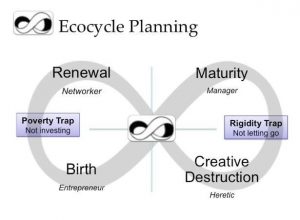 My friend and colleague Eva Schiffer asked the most delightful question after I wrote about Facilitating in Complex Contexts. “How do you dive into and acknowledge complexity and then get s*&% done?”
My friend and colleague Eva Schiffer asked the most delightful question after I wrote about Facilitating in Complex Contexts. “How do you dive into and acknowledge complexity and then get s*&% done?”
I love that Eva framed this as a classic Wicked Question focusing on the AND versus either/or! I’m finally circling back to share what I learned. (Back in the writing saddle again!)
I enjoyed this article in Learning Solutions by Connie Malamed addressing push back on Design Thinking. When I’m using Liberating Structures to enable design, planning, group process in complex contexts, there is this pervasive energy that shows up around the idea that “everything is complex,” and therefore there is nothing concrete we can do.” Another type of push back.
While I could blithely respond that they are missing the point, that’s not very helpful. Connie’s article broke down some of the resistance she has experienced with Design Thinking, so borrowed her approach and see if it works when trying to bring complexity friendly approaches to facilitation. Let me know…
Criticism: If everything is always complex and changing, how do you plan?
Cure: Discern what is complex, what isn’t and what can be “nudged” to a point of greater certainty or predictability. Using Agreement-Certainty matrix, the Cynefin Framework help in that discernment. If you think of your work portfolio in the  context of an Ecocycle, there are things that are predictable (in the “Manage” quadrant”) AND there are things that must be destroyed to make room for innovation, innovation itself and the process of bringing that innovation into the Managed domain through iterative experimentation. If you can identify where each of your work processes fit in that ecocycle, you can breath a little easier because it is all connected… eventually!
context of an Ecocycle, there are things that are predictable (in the “Manage” quadrant”) AND there are things that must be destroyed to make room for innovation, innovation itself and the process of bringing that innovation into the Managed domain through iterative experimentation. If you can identify where each of your work processes fit in that ecocycle, you can breath a little easier because it is all connected… eventually!
Criticism: If I can’t predict outcomes, how will I know how to focus our work?
Cure: Utilize methods that help you discover possibilities in unexpected places such as Discovery and Action Dialog, those that allow you to iteratively move towards your goal or refine your goal. Consider Improv Prototyping or even Simple Ethnography. These can help us leap over our own cognitive biases — sometimes that alone is the problem, not complexity!
Cilliers wrote (again, via Chris Corrigan): “The elements interact dynamically by exchanging energy or information. These interactions are rich. Even if specific elements only interact with a few others, the effects of these interactions are propagated throughout the system. The interactions are nonlinear. ” This reminds us that our work is often non linear, even if our planning infers that it is. 😉
Criticism: If things are always changing, how do we make make ongoing decisions?
Cure: First, discern what kind of decisions you are making. Again, via Chris Corrigan / Paul Cilliers and complexity informed values: “Complex systems consist of a large number of elements that in themselves can be simple.” Understand which decisions are the simple or complicated ones and make them. For the complex elements, use methods such as Critical Uncertainties to build a portfolio of options so you are ready to make decisions to shift if the conditions change. Finally, are you even conscious about HOW you make decisions? Look at that for a few surprises!
Criticism: And now Eva’s : How do you dive into and acknowledge complexity and then get s*&% done?
Cure: Acknowledge that this is the Wicked Question and then plan your next step. The beauty of 15% Solutions and similar approaches are that you can find the AND between complexity and your next move. Use the Wenger-Trayner Value Creation framework to surface immediate value of your short term experiments rather than waiting for the “final evaluation!” You can use What, So What, Now What? to elicit the narrative fragments that can help you see the value created, even in uncertain or experimental moves.
One more from Cilliers/Chris: Complex systems are adaptive. They can (re)organize their internal structure without the intervention of an external agent. Chris notes that we must adapt – our plans, our actions, our strategies. So the bottom line is we have to move away from our adulation of certainty and just get on with it!
See also:
- http://www.hsdinstitute.org/resources/plan-in-uncertainty-strategic-adaptive-action.html
Very interesting post, Nancy. I think you’re on the right track disentangling the process complexities around addressing wicked problems. One suggestion: when trying to find the right focus, there may be a tendency when using techniques like Improv Prototyping and Simple Etnography to start from scratch over and over again. What if there is a mediating knowledge commons that can be tapped into to seed and capture the key insights from such sessions? Using participatory mapping to capture key insights and using them as inputs for the next session might be a way to provide the “conceptual glue” between separate processes. Combining situated sensemaking processes with structured communal knowledge mapping and knowledge (re)presentation might be a way forward to scaling up the tackling of complexity. What do you think?
Good additions and amplifications, Aldo. Thanks! I think your suggestion would be interesting to merge with the idea of Panarchy, which is Ecocycle at many levels and which would provide context for building upon/learning from __(whatever)_ in the process. http://www.liberatingstructures.com/32-panarchy/
Like your network mapping, all of this work in complex contexts seems to benefit from representations that, as you often write, are not THE MAP, but ways to see connections, patterns and relationships through a process that engages us at many levels and senses.
Very cool, Nancy. The Panarchy concept sounds like a very interesting linking pin between the worlds of mapping in facilitation. Would be great to an experiment, with “blank Panarchy charts” being seeded by relevant excerpts from an evolving map. We need to talk! 🙂